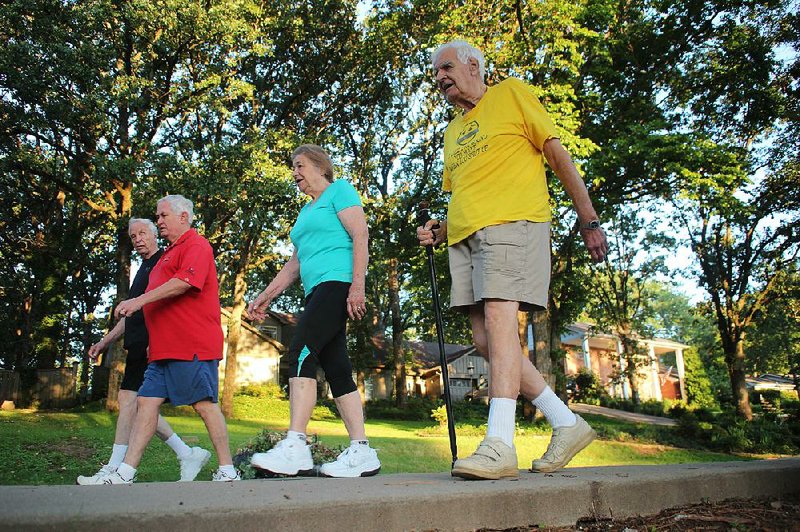Four workout buddies are taking 40 minutes or so to walk 1.6 miles, but they are not strolling, they are fitness walking. Let's try to keep up with them.
One using a cane, one who had a hip replaced five years ago ... how hard could it be?
That depends. How quickly can you answer questions with facts? Facts about historic events, famous people's birth years, local events in this lifetime, animal behavior ...?
Think fast, because we're not just taking a walk. We're taking a quiz.
1. What was the name of the hurricane and in what year did it kill 6,000 to 8,000 people in Galveston, Texas?
a. Great Galveston Hurricane in 1900.
b. Hurricane Hazel in 1954.
c. Hurricane Carla in 1961.
Planting his cane decisively with every step, Price Harris poses the question -- and by the way, without any multiple-choice crutches -- just before sunrise May 30 as he and three friends begin their usual workout in North Little Rock. They walk from the parking strip in front of the Lakewood Property Owners Association activity center and go counterclockwise around Lakewood Lake No. 3 twice -- as they have most weekday mornings for about 20 years.
Picture four people loosely bunched, each at his own pace but speeding up or slowing down to stay within easy conversational range -- and one is a bit hard of hearing. All set off briskly, but by the end of their second circuit, three have slowed considerably.
Slowed doesn't mean slacking. See Harris moving with determined effort, at times frowning, using a cane to offset twisting in his spine.
Harris turned 85 on June 1, the first day of Atlantic hurricane season, hence the topic he researched for today's quiz. He used to be a pilot. He was a flight trainer based at Nakhon Phanom, Thailand, in 1967-1968 during the Vietnam War. Later he made his career in insurance as an expert in loss prevention. He is a use-it-or-lose-it kind of guy.
So are his buddies. They long ago absorbed the information that cardiovascular conditioning abets longevity. More recently, research suggests that exercise and mental stimulation work hand-in-hand, and that being curious and actively trying to learn new things combat mental decline. (To stimulate your brain by reading one such study, see "Exercise training increases size of hippocampus and improves memory" at bit.ly/1J2iybb. Less taxing is "Eight Habits That Improve Cognitive Function" by Psychology Today columnist Christopher Bergland; see bit.ly/1BVbl8Q.)
So this walk is a healthy-aging support group, which means -- bad news -- answers are required. No silent hiding allowed. In a voice at once halting and firm, Harris calls on his partners:
"Janet?"
Janet Dilday, 85, is a retired kindergarten teacher. "I got a late start," she says. "I didn't start teaching until all my girls went to school. I taught about 20 years and then I quit early, too. But that was the only job I ever had." Unless you count being married for 64 years.
"Joe?"
Joe Dilday, 87, is a retired chemical engineer and Janet's husband. Back in the day, he invented something called "coated fertilizer," described in his patent filing thus: "Tenacious coatings of fertilizer supplements are applied to granular high analysis fertilizers, by adding, in order, minor amounts of mineral oil and of aqueous calcium lignosulfonate ...."
"Drew?"
Drew Hodges, 70, is a former stockbroker who became a history teacher and still is. He's adjunct faculty for the University of Central Arkansas a̶n̶d̶ ̶H̶e̶n̶d̶r̶i̶x̶ ̶C̶o̶l̶l̶e̶g̶e̶ in Conway, Arkansas State University-Beebe and National Park College in Hot Springs. In general he uses the energy of inferior age to keep the group moving at a steady pace, and to change quiz topics when he feels like it.
"Drew is a good teacher," Janet Dilday says. "One time we all went and audited a class he taught."
Were they disruptive?
Janet Dilday: "We were nice, weren't we, Drew?"
Hodges: "You were very gracious."
"We sat back and listened," Harris says. "His teaching method is to let the students cover a subject, and when they finish Drew will say, 'Very good, I would like to point out ...' and then he will cover the information they failed to bring out."
Hodges knows the date of the Great Galveston Hurricane.
"1900," Harris agrees, definitively. "OK. Hurricane Andrew. When and where?"
PROXIMITY
"We've got a whole subculture here of walkers," Hodges says as he watches two women moving fast on the other side of the lake. "There may be 25 or 30 regulars that I'm familiar with their faces. If I say, 'I've never seen you down here walking,' they'll say, 'Well, it's my first time.' Oftentimes that happens. We might not know everybody's name but we know the regulars. And we know who they walk with."
Seeing one another every day brought them together, but they debate when exactly that happened. Hodges thinks the late 1990s, Harris thinks 2000.
They were exercising individually for heart health. "And I wanted to lose weight," Joe Dilday says.
The others, including his wife, howl in disbelief, because he's tall and reed-thin.
Joe: "I weighed 202 pounds when I started walking."
Janet: "You did?"
"We all just were walking around the lake and we finally said hello to each other," Harris says. "We could keep up with each other. At the time I could walk fast."
Harris was a client of Hodges' brokerage in 1993. And Harris knew the Dildays from church. And, Hodges says, "I knew Janet and Joe because of the PEO. My wife is a PEO sister of Janet's."
2. What is PEO International?
a. A women's scholarship-funding club formed during the Civil War to help women attend college.
b. A women's scholarship-funding club founded by seven students at Iowa Wesleyan College in Mount Pleasant, Iowa, in 1869. The original meaning of PEO is secret, but the website states it stands for "Philanthrophic Education Organization."
PEO actually means "Pretty, Every One" or "Phone Each Other," Hodges jokes.
CIRCLE THE BEST ANSWER
Enough scene-setting, let's see how well we might do on questions drawn from these walkers' workouts May 30 and 31.
No internet searching allowed.
3. When and where did Hurricane Andrew make landfall?
a. Florida in 1992. Harris went to Key West in 1993 and saw what was left of Homestead Air Force Base -- nothing.
b. Florida in 1992. Hodges and his wife, Mary Jane, drove through the remnants of it in New York and had to pull off the road.
c. a and b
4. How many mobile homes did Andrew leave standing in Homestead, Fla.?
a. nine of 1,176 mobile homes.
b. 90 percent.
5. Which actress had seven husbands and died at age 79?
Harris: Elizabeth Taylor.
Hodges: Oh, that's easy, Price.
6. Can elephants get Alzheimer's?
a. No, they never forget anything.
b. No, captive elephants are always very healthy because they are always doing arts and crafts and meeting new people.
c. It is not known. Captive elephants confined in small spaces can suffer orthopedic damage leading to brain damage, and overstressed captive elephants become confused. But the brains of wild elephants have not been studied for Alzheimer's-like damage.
7. Can mallards mate with ducks that are not mallards and have hybrid ducklings?
a. No, mallard is a species.
b. No, mallards mate mallards, for life.
c. Yes, and even though they help raise their ducklings, the males slip away to force themselves on other females, of whatever species.
8. What is phrenology?
a. A 19th-century pseudo science that linked character and intellect to the shape and size of the cranium.
b. Cutting-edge science that allows a wealthy family to test the suitability of potential sons-in-law by feeling their skulls for lumps.
c. A DNA-testing method that proves mallards can mate with other ducks.
9. What is giraffe stone?
a. A veneer method in which flat slabs of sandstone are laid like an irregular quilt over a wood or concrete frame and joined with light-colored mortar.
b. The two ends of the rock formation known as a natural bridge.
c. A construction method favored by the forgotten men of two New Deal "alphabet agencies," the Federal Deposit Insurance Corp. (FDIC) and the Reconstruction Finance Corp. (RFC).
INSPIRED
One minute tree shadows soften the walkers' concentrating faces, and the next, rising sunlight blasts the big aeration fountains out in the lake, scattering dazzles and painting bright stripes along their bodies and the pavement.
A crossbreed duck family ripples the water. Behind the obviously mallard mother and the father that is who knows what, nine or possibly 14 noisy ducklings appear and disappear as though by magic. This proves, Harris, says, their crossbreeding, because mallards dabble, they don't submerge.
And then, as though proving the Doppler effect, a small herd of jogger/walkers going clockwise around the lake chatters past, briefly drowning out and then drowned out by ducks.
All in their early 60s, Debbie Freear Strobel and her running partners, Kathleen McComber and her twin sister, Mary Alice Spann, already have decades of running and walking behind them.
"We see that group every morning and they are an inspiration to us," McComber says of the quiz-walkers. "Didn't know they played trivia while exercising!"
But are they? Is it trivia?
10. What is the origin of the word "trivia"?
a. The Latin word triviae described the place where a road forked into two roads, creating three roads (counting the first one). It was applied to mean a "public place," in other words, a common place -- hence the modern interpretation of trivia as commonplace.
b. In medieval Latin, the Trivia were three fundamental liberal arts -- grammar, logic and rhetoric.
c. both a and b.
Another near-daily lake walker, 90-year-old Dorothy Snow, has lived in the Lakewood area since 1953. She is well aware of the four buddies' intellectual pursuits.
"When I walk and I catch up with them, I say to them, 'What are y'all talking about?' If it's something I want to know, I stay and talk to them," she says. "And if it's not? I speed up."
ActiveStyle on 06/12/2017
*CORRECTION: Drew Hodges has taught history at the University of Central Arkansas in Conway, Arkansas State University-Beebe and National Park College in Hot Springs. A previous version of this article incorrectly included a fourth college.


